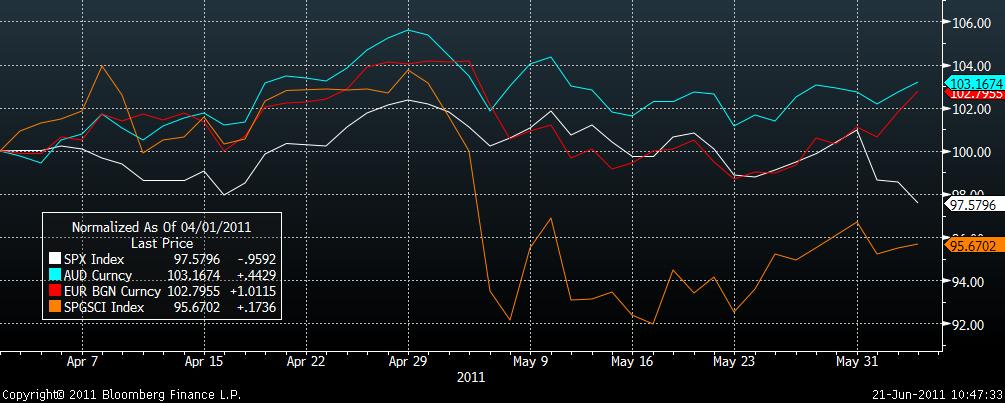We haven’t seen a real risk off event yet as most people seem still to be trading as if there is going to be a resolution to the Greek crisis and also, I think, because all the recent volatility has pushed people to the sidelines. So the Aussie has actually been performing superbly all things considered as you can see in the chart below.
Also charted are the S&P 500, EUR/USD, GS Commodities Index and the AUD/USD. They are all indexed to 100 as at April 1st this year and you can see the Aussie has out performed by a mile.
Clearly part of this is the fact that, as we have talked a lot about recently, there has been a re-rating of the Aussie dollar. So there has been much debate on whether a real risk off event will prove this theory to simply be a bull market reflection of recent market price action.
My view remains that the fact that the Aussie has been rerated, as I believe it has, doesn’t mean that the volatility that we are used to for the Aussie will necessarily be absent. Rather as the 5 th most traded currency in the world and the AUD/USD cross the 4th most traded pair (BIS triennial FX Survey 2010) the Aussie is punching well above its weight.
Indeed you have to say that if the Aussie trades this much it is the world’s favourite punt probably rivaling cricket in the sub-continent.
So I find it amusing when I hear people who get the structural positives mixed up with the usual cyclical forces that drive the Aussie and other currencies and so feel they must be perma bulls or in the past perma bears when referencing their views on the Aussie.
The key is that, as Glenn Stevens said last week, currencies are asset markets, anyone who doesn’t understand that should not go anywhere near the currency maarkets to trade or invest.
This underlines the point I made above about the Aussie punching above its weight and why I always talk about ‘investment fundamentals’ rather than just simple economic fundamentals. If currencies are assets then they’ll trade like assets. And as a much bigger part of people’s portfolios than the size of the economy suggests is prudent, when people hedge or cut their bets the Aussie gets sold as they get back toward home, or benchmark.
So if Europe muddles through without creating a massive mess then Aussie is likely to do much better than most, but as Sean Callow from Westpac is quoted as saying in the SMH this morning:
”We don’t have to go as far back as the global financial crisis to see how badly the Australian dollar can be hit by global financial linkages.
”In May 2010, the Greek crisis mark 1 saw the dollar hit harder than even the euro,” he said. ”For all its merits, the Australian dollar remains very sensitive to equity markets and global risk appetite.”
Yeah, it does. Even though the time of the cycle that the Aussie turns into a pumpkin has been pushed back later, like Cinderella, the Aussie is just waiting for the bells of midnight (Greek default maybe?) to turn back into its ugly old self.
